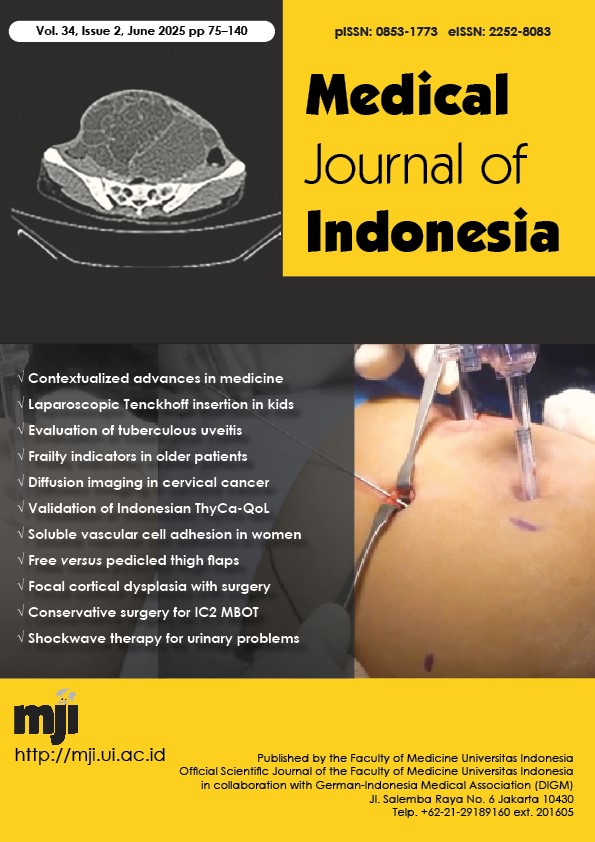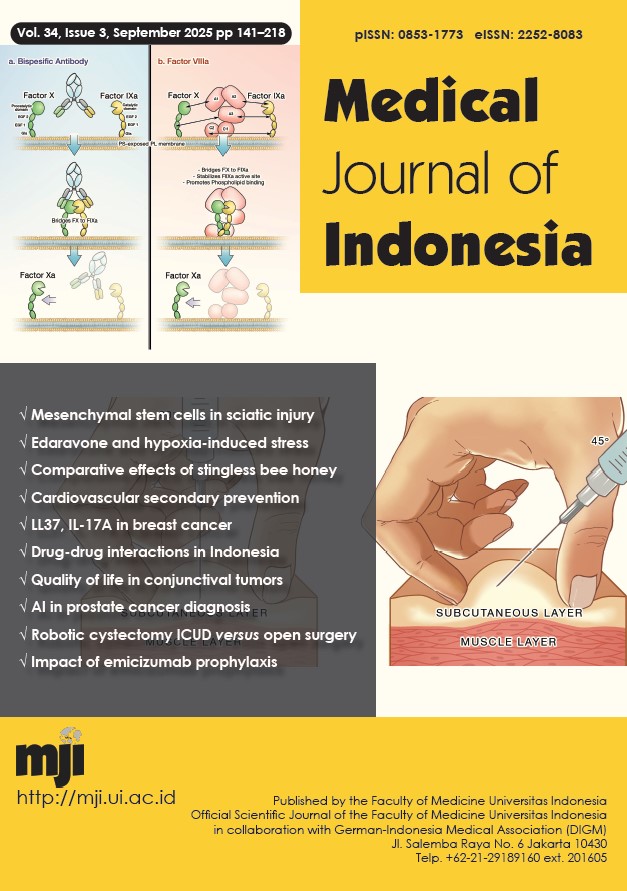Tumor apparent diffusion coefficient value and ratio in magnetic resonance imaging on cervical cancer
DOI:
https://doi.org/10.13181/mji.oa.257715Keywords:
cervical cancer, diffusion magnetic resonance imaging, magnetic resonance imagingAbstract
BACKGROUND Diffusion-weighted magnetic resonance imaging (DW-MRI) is a noninvasive, non-contrast sequence for cancer detection. Research involving DW-MRI in cervical cancer has revealed lower apparent diffusion coefficient (ADC) values. This study aimed to evaluate the difference in tumor ADC values and ADC ratios (tumor-to-urine and tumor-to-muscle) with respect to tumor staging (early versus late) and histopathology (squamous cell carcinoma versus adenocarcinoma).
METHODS This retrospective study included 56 patients with cervical cancer, divided into early- and late-stage groups. DW-MRI was performed in all patients, and the tumor ADC value, ADC ratio between the tumor and urine (ADC ratiot−u), and ADC ratio between the tumor and gluteal muscle (ADC ratiot−m) were measured. Statistical methods were employed to assess the difference in the tumor ADC value, ADC ratiot−u, and ADC ratiot−m with respect to cervical cancer stages and histopathological findings.
RESULTS The median tumor ADC value was lower in the early-stage group than in the late-stage cervical cancer (0.75 × 10−3 mm²/s versus 0.8 × 10−3 mm²/s, p = 0.022). However, no differences were observed in ADC ratiot−u and ADC ratiot−m concerning the tumor staging, nor in ADC value, ADC ratiot−u, and ADC ratiot−m concerning histopathological findings (p = 0.29, 0.67 and 0.35, respectively), with no significant differences in the ADC ratiot−u (p = 0.153) and ADC ratiot−m (p = 0.260). In receiver operating characteristic analysis, the tumor ADC value was 75.0% sensitive and 50.0% specific in predicting late-stage cervical cancer with a cut-off value of 0.750 × 10−3 mm2/s.
CONCLUSIONS The median tumor ADC value in early-stage patients was significantly lower than in the late-stage patients, suggesting that tumor ADC value has valuable potential for characterizing cervical cancer staging.
Downloads
References
The Catalan Institute of Oncology (ICO) and the International Agency for Research on Cancer (IARC) Information Centre on HPV and Cancer. Indonesia: Human papillomavirus and related cancer, fact sheet 2023 [Internet]. Barcelona: The Catalan Institute of Oncology (ICO) and the International Agency for Research on Cancer (IARC) Information Centre on HPV and Cancer; 2021 [cited 2021 Apr 20]. Available from: https://hpvcentre.net/statistics/reports/IDN_FS.pdf.
International Agency for Research on Cancer. Cancer today [Internet]. Lyon: International Agency for Research on Cancer; 2021 [cited 2021 Apr 20]. Available from: https://gco.iarc.fr/today/online-analysis-multi-bars.
Nuranna L, Prastasari R, Sutrisna B. Survival of cervical cancer patients and its prognostic factors at Cipto Mangunkusumo Hospital, Jakarta. Med J Indones. 2014;23(3):163-8. https://doi.org/10.13181/mji.v23i3.739
Bourgioti C, Chatoupis K, Moulopoulos LA. Current imaging strategies for the evaluation of uterine cervical cancer. World J Radiol. 2016;8(4):342−54. https://doi.org/10.4329/wjr.v8.i4.342
Bhatla N, Aoki D, Sharma DN, Sankaranarayanan R. Cancer of the cervix uteri. Int J Gynaecol Obstet. 2018;143 Suppl 2:22−36. https://doi.org/10.1002/ijgo.12611
Vinaik T. Study of response and outcome of treatment of radiotherapy in patients of carcinoma cervix stage IIB-IV with concurrent cisplatin. Int J Med Sci Public Health. 2018;7(8):661-6. https://doi.org/10.5455/ijmsph.2018.0413702052018
Rahakbauw E, Winarto H. Radiotherapy response and related clinicopathological factors of patients with cervical cancer. J Phys Conf Ser. 2018;1073(3):032040. https://doi.org/10.1088/1742-6596/1073/3/032040
Dashottar S, Preeth Pany T, Lohia N. Role of apparent diffusion coefficient as a biomarker in the evaluation of cervical cancer. Indian J Radiol Imaging. 2019;29(1):25−32. https://doi.org/10.4103/ijri.IJRI_441_18
Ministry of Health of the Republic of Indonesia. [Cervical cancer] [Internet]. Jakarta: Ministry of Health of the Republic of Indonesia; 2017 [cited 2021 Apr 12]. Available from: http://kanker.kemkes.go.id/guidelines/backup/PNPKServiks.pdf. Indonesian.
Dappa E, Elger T, Hasenburg A, Düber C, Battista MJ, Hötker AM. The value of advanced MRI techniques in the assessment of cervical cancer: a review. Insights Imaging. 2017;8(5):471−81. https://doi.org/10.1007/s13244-017-0567-0
Liu B, Ma WL, Zhang GW, Sun Z, Zhong JM, Wei MQ, et al. Changes in magnetic resonance T2-weighted imaging signal intensity correlate with concurrent chemoradiotherapy response in cervical cancer. J Contemp Brachytherapy. 2019;11(1):41−7. https://doi.org/10.5114/jcb.2019.83285
Bajgiran AM, Mirak SA, Sung K, Sisk AE, Reiter RE, Raman SS. Apparent diffusion coefficient (ADC) ratio versus conventional ADC for detecting clinically significant prostate cancer with 3-T MRI. AJR Am J Roentgenol. 2019;213(3):W134−42. https://doi.org/10.2214/AJR.19.21365
Tamada T, Prabhu V, Li J, Babb JS, Taneja SS, Rosenkrantz AB. Assessment of prostate cancer aggressiveness using apparent diffusion coefficient values: impact of patient race and age. Abdom Radiol (NY). 2017;42(6):1744−51. https://doi.org/10.1007/s00261-017-1058-y
Barrett T, Priest AN, Lawrence EM, Goldman DA, Warren AY, Gnanapragasam VJ, et al. Ratio of tumor to normal prostate tissue apparent diffusion coefficient as a method for quantifying DWI of the prostate. AJR Am J Roentgenol. 2015;205(6):W585−93. https://doi.org/10.2214/AJR.15.14338
Shaaban MS, Ayad VG, Sharafeldeen M, Salem MA, Atta MA, Ramadan AA. DWI and ADC value versus ADC ratio in the characterization of solid renal masses: radiologic-pathologic correlation. Egypt J Radiol Nucl Med. 2021;52(203). https://doi.org/10.1186/s43055-021-00565-3
Hasan DI, Enaba MM, Abd El-Rahman HM, El-Shazely S. Apparent diffusion coefficient value in evaluating types, stages and histologic grading of cancer cervix. Egypt J Radiol Nucl Med. 2015;46:781-9. https://doi.org/10.1016/j.ejrnm.2015.04.006
Lin Y, Li H, Chen Z, Ni P, Zhong Q, Huang H, et al. Correlation of histogram analysis of apparent diffusion coefficient with uterine cervical pathologic finding. AJR Am J Roentgenol. 2015;204(5):1125−31. https://doi.org/10.2214/AJR.14.13350
Wang M, Huang K, Wong MC, Huang J, Jin Y, Zheng ZJ. Global cervical cancer incidence by histological subtype and implications for screening methods. J Epidemiol Glob Health. 2024;14(1):94−101. https://doi.org/10.1007/s44197-023-00172-7
Rana MK, Singh K, Mahajan MK, Rana AP. Clinicopathological profile of cervical carcinoma: an experience of tertiary care cancer centre. Asian Pac J Cancer Care. 2019;4(3):83-6. https://doi.org/10.31557/apjcc.2019.4.3.83-86
Published
How to Cite
Issue
Section
License
Copyright (c) 2025 Trifonia Pingkan Siregar, Septelia Inawati Wanandi, Sawitri Darmiati, Fitriyadi Kusuma, Sri Mutya Sekarutami, Lisnawati, Joedo Prihartono, Muhammad Ilyas, Ginva Amalia, Khalida Ikhlasiya Tajdar Gefariena Elfahmi

This work is licensed under a Creative Commons Attribution-NonCommercial 4.0 International License.
Authors who publish with Medical Journal of Indonesia agree to the following terms:
- Authors retain copyright and grant Medical Journal of Indonesia right of first publication with the work simultaneously licensed under a Creative Commons Attribution-NonCommercial License that allows others to remix, adapt, build upon the work non-commercially with an acknowledgment of the work’s authorship and initial publication in Medical Journal of Indonesia.
- Authors are permitted to copy and redistribute the journal's published version of the work non-commercially (e.g., post it to an institutional repository or publish it in a book), with an acknowledgment of its initial publication in Medical Journal of Indonesia.






































